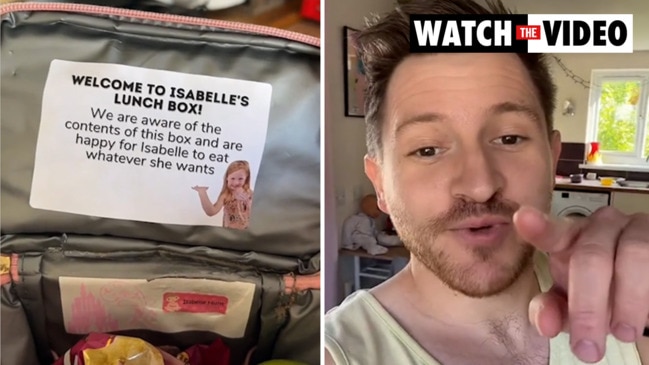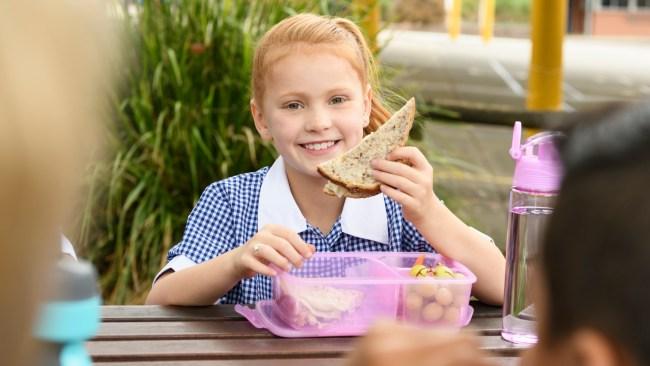This toxic variation of lunchbox shaming needs to stop
Parents across the country are feeling the pinch of cost-of-living pressures, but unfortunately it's leading to an unwanted new type of bullying around Australian schoolyards.

Family Life
Don't miss out on the headlines from Family Life. Followed categories will be added to My News.
Criticism or judgement of the contents of what is in, or not in a child’s school lunchbox; along with how it’s packed, and presented and what sort of lunchbox it is, AKA lunchbox shaming isn’t new.
Over recent months though, due to cost-of-living pressures impacting so many Aussie families’ budgets, this toxic trend has taken on a new form where students and parents are being shamed for their more affordable lunchbox items.
Whether it’s reduced oddly shaped produce, home brand pantry items, fewer canteen days or types of snacks, or leftovers for lunch, the pivots of many student’s lunchbox contents are being noticed and, in some cases, unfairly judged by others.
Want to join the family? Sign up to our Kidspot newsletter for more stories like this.
And the numbers are alarming, with new research from Real Insurance, showing that close to half of Aussie parents (43%) have felt lunchbox shamed in the schoolyard.
The research comes as a part of the Real Healthy Kids Report which shows that the rising cost of living continues to put pressure on Aussie families, revealing that 77 per cent of parents are feeling the financial strain of providing healthy food, spending an average $8,294 annually on nutritious diets.
RELATED: Mum lunchbox shamed for packing 'disgusting' food

"Why do you shop at Aldi? Can't you afford a real supermarket?"
For some families the rising costs of fresh produce ($10 punnets of berries for one) means that fruit bowls aren’t as full as they once had been, some cleaner pantry snacks are no longer affordable and other ‘healthy lunchbox-approved’ items are just simply unattainable.
Another way the increase in the cost of living has affected Australians is where we shop and the brands we buy, with lots of people switching from major supermarkets to smaller businesses or independent stores or swapping brand names for home brand products.
According to my kids and some other parents I’ve spoken to though, this is one of the ways that some children are being lunchbox shamed.
My primary school-aged girls have told me about a few instances where kids will compare what is inside their lunchbox. Usually, it is to work out if they can “swap up” – swap something they don’t want in their own lunchbox for something that another kid doesn't want in theirs (and the reason why I always find random wrappers returning in their lunchbox).
Introducing our new podcast: Mum Club! Listen and subscribe wherever you get your podcasts so you never miss an episode.
While normally this isn’t really a problem, more recently and on more than a few occasions, my kids have said that when others have brought in food to school that isn’t what they have usually had, items from Aldi, home brand alternatives of snacks, or leftovers, upon observing this change, some kids will make comments.
Unfortunately, these comments aren’t usually nice, they can be judgemental and nasty.
“Are you poor?”
“Why do you shop at Aldi Can't you afford a real supermarket?”
“That’s not a real RollUp,” comments to that effect.
RELATED: ‘Where are the carbs’: Mum slammed for preschoolers’s keto lunchbox

"The schools are pushing quite expensive foods"
It’s behaviour that transitions into many other areas too, especially clothing and shoes. In a world where tweens and kids are brand-obsessed, anything that’s not deemed ‘cool’ is often the topic of discussion and unfortunately, judgement.
While these sorts of comments are unfair and hurtful for the kids hearing them first-hand, they aren’t the only people affected with the research finding that many parents find it challenging to meet expectations set by schools around health standards (60%), and struggle to keep pace with the efforts of other parents (63%).
“I used to pride myself on all of the fresh fruit and vegetables I included in my sons’ lunchboxes but with the continual rise in food prices this variation just isn’t attainable,” says NSW mum of three, Kellie.
Kellie says her school will send home regular reminders about health eating guidelines for lunchboxes and include them in most newsletters too.
“These push often quite expensive foods, ones that were once always in our house but are ones at the moment we simply can't afford,” she says.
This proactive decision by the school, Kellie and many other school parents who are under financial pressure find the approach insensitive and a form of lunchbox shaming.
“I don’t know if they’ve even really considered that sending these constant messages home about what to include and not include in a lunchbox, with an emphasis on nutritious yet currently overly expensive items, isn’t very considerate of the climate,” Kellie says.
“Either way though, it frustrates me and many other parents who are feeling the pinch and it makes us feel even more guilty than we already do.”
And Kellie sums it up perfectly, in a world where most parents are trying their best to provide for their family – financially, nutritionally and every other way- these attitudes and actions don’t help anyone, they just make it worse.
More Coverage
Originally published as This toxic variation of lunchbox shaming needs to stop





